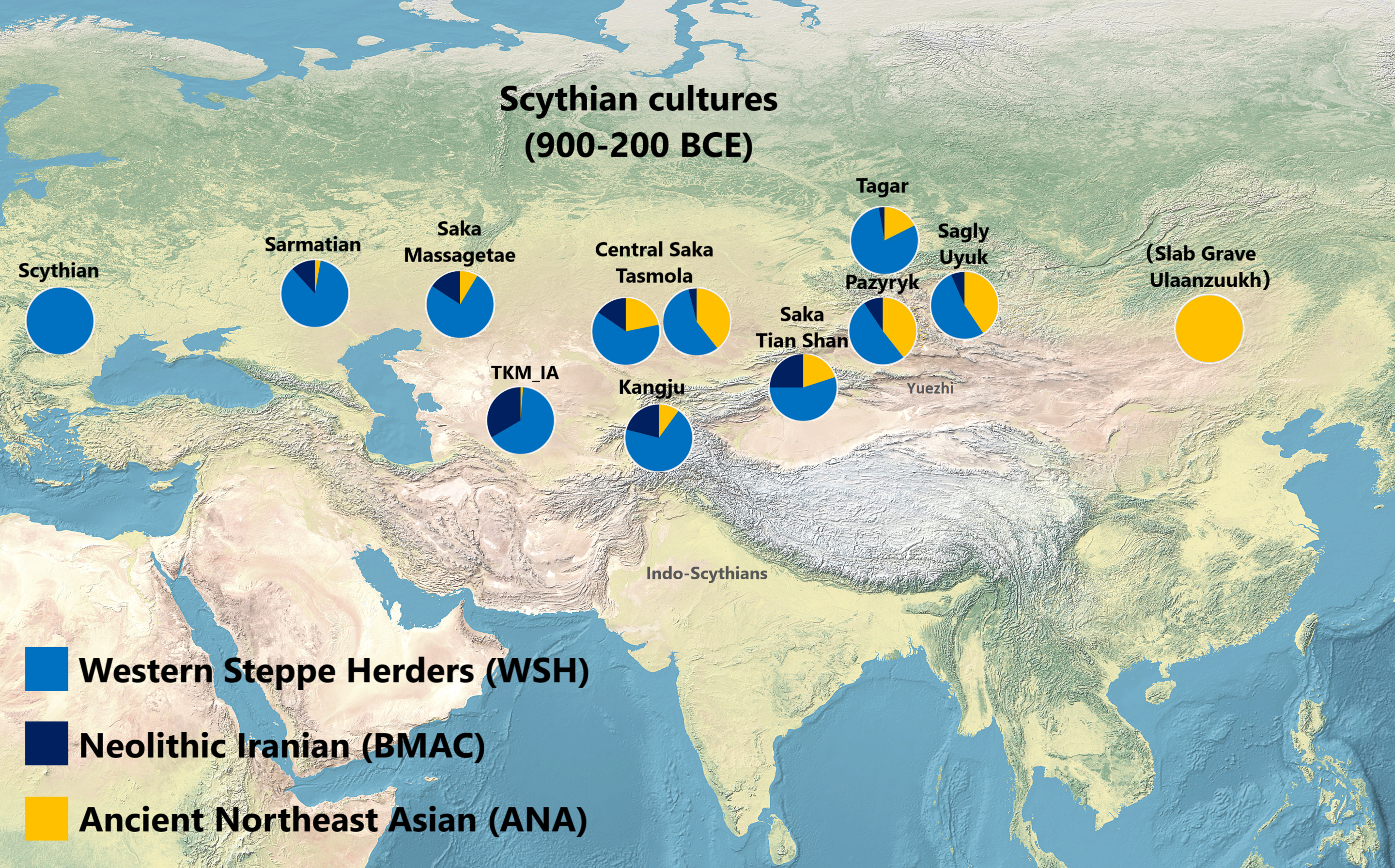Eurasian steppe people, so horse-warrior nomads, 2900 to 1800 years ago, spoke the Scythian language (member of the Eastern Iranic language family). Mostly Indo-European, more specifically Irano-Aryan, but mixed with Ancient Northeast Asian (ANA) ancestry (think speakers of Turkic, Mongolic and Tungusic people) the further you go East. But the Scytho-Siberian world included some other peoples from Central Asia and Siberia, Eastern Europe.
Their way of life probably originated in the East in southern Siberia more on the ANA side of the spectrum and then it migrated west and picked up more Indo-European traits.
They like horses, gold, war, Phrygian caps, various hard drugs, weird sex rituals, animal&human sacrifices and possibly even cannibalism.
On their religion from Wikipedia:
"According to Herodotus of Halicarnassus, the Scythians worshipped a pantheon of seven gods and goddesses (heptad), which he equates with Greek divinities of Classical Antiquity following the interpretatio graeca. He mentioned eight deities divided into three ranks, with this structure of the Scythian pantheon being typically Indo-Iranic:
In the first rank was the head of the pantheon:
Tabiti, the Flaming One, who was the goddess of heat, fire and the hearth
In the second rank were the binary opposites and the father and mother of the universe:
Api, the Earth and Water Mother
Papaios, the Sky Father
3)The third and final rank was composed of four deities with specific characteristics:
Targī̆tavah, the forefather of the Scythian kings
The Scythian “Ares,” the god of war
Gaiϑāsūra, who might have been associated with the Sun
Artimpasa, a more complex goddess who was a patron of fertility and had power over sovereignty and the priestly force
An eighth Scythian deity mentioned by Herodotus was Thagimasadas, who was worshipped only by the tribe of the Royal Scythians.
This pantheon was a reflection of the Scythian cosmology, headed by the primeval fire which was the basic essence and the source of all creation, following which came the Earth-Mother and Sky-Father who created the gods, the latter of whom were the four custodians of the four sides of the world regulating the universe.[11] The world inhabited by humans existed between this celestial realm and the chthonic realm below the earth.[8]"
Here’s a few illustrations:
WSH here is basically Indo-European, BMAC is Neolithic Iranian and ANA as explained earlier, like Mongols etc.:
Never heard of them. Can you elaborate?
Think Huns, but they’re Aryan (Indo-Iranians called themselves that).
Here’s a good detailed video.
Eurasian steppe people, so horse-warrior nomads, 2900 to 1800 years ago, spoke the Scythian language (member of the Eastern Iranic language family). Mostly Indo-European, more specifically Irano-Aryan, but mixed with Ancient Northeast Asian (ANA) ancestry (think speakers of Turkic, Mongolic and Tungusic people) the further you go East. But the Scytho-Siberian world included some other peoples from Central Asia and Siberia, Eastern Europe.
Their way of life probably originated in the East in southern Siberia more on the ANA side of the spectrum and then it migrated west and picked up more Indo-European traits.
They like horses, gold, war, Phrygian caps, various hard drugs, weird sex rituals, animal&human sacrifices and possibly even cannibalism.
On their religion from Wikipedia: "According to Herodotus of Halicarnassus, the Scythians worshipped a pantheon of seven gods and goddesses (heptad), which he equates with Greek divinities of Classical Antiquity following the interpretatio graeca. He mentioned eight deities divided into three ranks, with this structure of the Scythian pantheon being typically Indo-Iranic:
Tabiti, the Flaming One, who was the goddess of heat, fire and the hearth
Api, the Earth and Water Mother
Papaios, the Sky Father
3)The third and final rank was composed of four deities with specific characteristics:
Targī̆tavah, the forefather of the Scythian kings
The Scythian “Ares,” the god of war
Gaiϑāsūra, who might have been associated with the Sun
Artimpasa, a more complex goddess who was a patron of fertility and had power over sovereignty and the priestly force
An eighth Scythian deity mentioned by Herodotus was Thagimasadas, who was worshipped only by the tribe of the Royal Scythians.
This pantheon was a reflection of the Scythian cosmology, headed by the primeval fire which was the basic essence and the source of all creation, following which came the Earth-Mother and Sky-Father who created the gods, the latter of whom were the four custodians of the four sides of the world regulating the universe.[11] The world inhabited by humans existed between this celestial realm and the chthonic realm below the earth.[8]"
Here’s a few illustrations:
WSH here is basically Indo-European, BMAC is Neolithic Iranian and ANA as explained earlier, like Mongols etc.:
The first chad meme, I guess?
Very interesting, thanks!